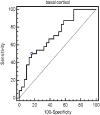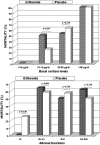The effects of moderate-dose steroid therapy in sepsis: A placebo-controlled, randomized study
- PMID: 22973341
- PMCID: PMC3430057
The effects of moderate-dose steroid therapy in sepsis: A placebo-controlled, randomized study
Abstract
Background: Despite the new developments in sepsis treatment, mortality rate is still high. In this study, we aimed to investigate endocrinologic changes and the effects of moderate dosage steroid treatment in patients with sepsis.
Methods: Fifty-five patients were included in the study. Basal hormonal evaluation and adrenocorticotropin hormone (ACTH) stimulation test were performed within 24 h in all patients. Both groups received standard treatment for sepsis. However, one group (steroid group) was also given intravenous prednisolone (20 mg/day). All-cause mortality was assessed during the first 28 days.
Results: Analysis of the findings revealed a 59.3% mortality rate in steroid group compared with a 53.6% mortality rate in placebo group (p = 0.787). Acute Physiology and Chronic Health Evaluation (APACHE) II and Sequential Organ Failure Assessment (SOFA) scores, and peak cortisol and ACTH levels were significant factors related to mortality. The incidence of adrenal insufficiency (AI) was 10.9% and relative adrenal insufficiency (RAI) 36.4%. It was also found that steroid treatment did not have any effects on the mortality of patients with AI and RAI (p = 0.075 and p = 0.999, respectively).
Conclusions: Moderate-dose steroid therapy has no effect on mortality. Higher basal cortisol and peak cortisol levels were found more reliable mortality indicators compared to RAI. In addition, the study revealed that ACTH level was a significant indicator of mortality.
Keywords: ACTH; Adrenal Insufficiency; Cortisol; Prednisolone; Sepsis.
Conflict of interest statement
Figures
Similar articles
-
Physiological-dose steroid therapy in sepsis [ISRCTN36253388].Crit Care. 2002 Jun;6(3):251-9. doi: 10.1186/cc1498. Epub 2002 Apr 19. Crit Care. 2002. PMID: 12133187 Free PMC article. Clinical Trial.
-
[Adrenal function evaluation using ACTH stimulation test in children with sepsis and septic shock].Zhonghua Er Ke Za Zhi. 2008 May;46(5):328-32. Zhonghua Er Ke Za Zhi. 2008. PMID: 19099747 Chinese.
-
Relationship between adrenal function and prognosis in patients with severe sepsis.Chin Med J (Engl). 2007 Sep 20;120(18):1578-82. Chin Med J (Engl). 2007. PMID: 17908474
-
The hypothalamic-pituitary-adrenal axis of patients with severe sepsis: altered response to corticotropin-releasing hormone.Crit Care Med. 2001 Feb;29(2):310-6. doi: 10.1097/00003246-200102000-00017. Crit Care Med. 2001. PMID: 11246311
-
Serum macrophage migration inhibitory factor reflects adrenal function in the hypothalamo-pituitary-adrenal axis of septic patients: an observational study.BMC Infect Dis. 2009 Dec 21;9:209. doi: 10.1186/1471-2334-9-209. BMC Infect Dis. 2009. PMID: 20021698 Free PMC article.
Cited by
-
Efficacy and safety of corticosteroids in critically ill patients: a systematic review and meta-analysis.BMC Anesthesiol. 2025 Jul 1;25(1):319. doi: 10.1186/s12871-025-03196-7. BMC Anesthesiol. 2025. PMID: 40597594 Free PMC article.
-
Corticosteroids for treating sepsis in children and adults.Cochrane Database Syst Rev. 2025 Jun 5;6(6):CD002243. doi: 10.1002/14651858.CD002243.pub5. Cochrane Database Syst Rev. 2025. PMID: 40470636 Review.
-
Corticosteroids for Treating Sepsis in Adult Patients: A Systematic Review and Meta-Analysis.Front Immunol. 2021 Aug 16;12:709155. doi: 10.3389/fimmu.2021.709155. eCollection 2021. Front Immunol. 2021. PMID: 34484209 Free PMC article.
-
Glucocorticosteroids for sepsis: systematic review with meta-analysis and trial sequential analysis.Intensive Care Med. 2015 Jul;41(7):1220-34. doi: 10.1007/s00134-015-3899-6. Epub 2015 Jun 23. Intensive Care Med. 2015. PMID: 26100123 Free PMC article.
-
Association of Corticosteroid Treatment With Outcomes in Adult Patients With Sepsis: A Systematic Review and Meta-analysis.JAMA Intern Med. 2019 Feb 1;179(2):213-223. doi: 10.1001/jamainternmed.2018.5849. JAMA Intern Med. 2019. PMID: 30575845 Free PMC article.
References
-
- Angus DC, Wax RS. Epidemiology of sepsis: an update. Crit Care Med. 2001;29(7 Suppl):S109–S116. - PubMed
-
- Annane D, Bellissant E, Cavaillon JM. Septic shock. Lancet. 2005;365(9453):63–78. - PubMed
-
- Cooper MS, Stewart PM. Corticosteroid insufficiency in acutely ill patients. N Engl J Med. 2003;348(8):727–34. - PubMed
-
- Lipiner-Friedman D, Sprung CL, Laterre PF, Weiss Y, Goodman SV, Vogeser M, et al. Adrenal function in sepsis: the retrospective Corticus cohort study. Crit Care Med. 2007;35(4):1012–8. - PubMed
-
- Zaloga GP. Sepsis-induced adrenal deficiency syndrome. Crit Care Med. 2001;29(3):688–90. - PubMed
LinkOut - more resources
Full Text Sources


